WHIPTAIL CATFISH 5-7CM PLECO LIVE TROPICAL FISH TANK ALGAE EATER, Easy-Care Tropical Fish Species for Beginners, Enhancing Your Aquarium with Natural Grace, Beautiful Algae Eaters for Freshwater Habitats
£9.49 Original price was: £9.49.£7.74Current price is: £7.74.
Welcome these beautiful Whiptail Catfish, elegant algae eaters perfect for community tanks. These gentle freshwater fish enhance your aquarium’s natural beauty and thrive when cared for properly. Ideal for beginners seeking peaceful companions in their aquatic environment.
982 in stock
Species Introduction
The Whiptail Catfish, scientifically known as Corydoras paleatus, is a member of the Callichthyidae family, renowned for its unique appearance and gentle demeanor. Originating from the freshwater rivers and streams of South America, particularly in regions like Argentina and Paraguay, this species thrives in slow-moving waters rich in organic material. Their natural habitat includes sandy substrates and dense vegetation, which provide ample hiding spots and foraging opportunities. As a tropical fish, the Whiptail Catfish is well-suited for community tanks, making it a favored choice among aquarists looking to enhance their aquarium with a peaceful and efficient algae eater. With a maximum length of approximately 7cm, these fish are an ideal size for smaller aquariums, yet they offer significant contributions to the ecosystem of any tank they inhabit.
Care Requirements Dashboard
Essential Care Guide for Your Whiptail Catfish
| Optimal Living Conditions | |
|---|---|
| Water Temperature | 22-28°C (72-82°F) |
| pH Level | 6.0-7.5 |
| Water Hardness | 2-15 dKH |
| Minimum Tank Size | 120L (30 gal) |
| Salinity | Freshwater |
| Care Level | Beginner to Intermediate |
✓ Care Level: Easy
Tank Size: Minimum 30 liters (8 gallons)
Water Temperature: 22-28°C (72-82°F)
pH Level: 6.0-7.5
Water Hardness: 2-15 dGH
The Whiptail Catfish is an easy-care species, making it perfect for beginners. They require a minimum tank size of 30 liters to thrive, as they appreciate having space to swim and explore. Maintaining a stable water temperature between 22-28°C is crucial for their health, and a pH level of 6.0-7.5 is ideal. Additionally, the water hardness should range from 2 to 15 dGH. Regular water changes and monitoring of these parameters will ensure that your aquatic companions remain healthy and vibrant.
Natural Behavior & Temperament
The Whiptail Catfish is known for its peaceful nature and sociable behavior, making it an excellent addition to community tanks. These fish are bottom dwellers, often seen foraging along the substrate for food, which includes algae, detritus, and other organic materials. They exhibit a unique swimming pattern characterized by gentle undulations of their bodies, which allows them to navigate through their environment gracefully. In groups, they display interesting social interactions, often forming schools that enhance their sense of security. It is important to provide them with a well-planted tank that mimics their natural habitat, as this encourages their natural behaviors and helps reduce stress.
Tank Setup Guide
When setting up an aquarium for Whiptail Catfish, consider creating an environment that closely resembles their natural habitat. A sandy substrate is ideal, as it allows them to dig and forage comfortably. Incorporating smooth rocks, driftwood, and live plants not only enhances the aesthetic appeal of the tank but also provides hiding spots and territories for the fish. The addition of floating plants can help diffuse light and create shaded areas, which these fish appreciate. Ensure that the tank is well-filtered to maintain water quality, as Whiptail Catfish are sensitive to poor water conditions. A gentle water flow is preferable, as it mimics the slow currents of their natural environment.
Water Quality Management
✓ Water Quality: Essential for Health
pH Level: 6.0-7.5
Temperature: 22-28°C (72-82°F)
Hardness: 2-15 dGH
Maintaining optimal water quality is vital for the well-being of Whiptail Catfish. Regular water changes of 10-15% weekly help to keep nitrate levels low and ensure a healthy environment. It is important to monitor the pH level, temperature, and hardness regularly. A stable pH of 6.0-7.5 is ideal, while the temperature should be kept between 22-28°C. The hardness of the water should be maintained within the range of 2-15 dGH. Utilizing a quality filtration system will aid in achieving these parameters, and adding live plants can help in natural filtration.
Feeding & Nutrition
✓ Diet: Omnivorous
Feeding Schedule: 2-3 times a week
Food Types: Algae wafers, sinking pellets, fresh vegetables
The Whiptail Catfish is an omnivorous species that thrives on a varied diet. They are particularly fond of algae, making them excellent algae eaters in the aquarium. A balanced diet should include high-quality sinking pellets, algae wafers, and fresh vegetables such as zucchini and cucumber. It is recommended to feed them 2-3 times a week, ensuring that any uneaten food is promptly removed to maintain water quality. Observing their feeding behavior can provide insight into their health and well-being, as healthy fish will actively forage and consume their food.
Compatibility Guide
Whiptail Catfish are known for their peaceful nature, making them suitable for community tanks. They can coexist with various fish species, including other peaceful bottom dwellers and mid-water swimmers. Ideal tank mates include tetras, rasboras, and other corydoras species. However, it is essential to avoid aggressive fish or those that may outcompete them for food. The compatibility of tank mates should always be assessed, as individual fish personalities can vary. Providing ample space and hiding spots will help reduce stress and territorial disputes among fish friends.
Tank Mate Compatibility Guide
✅ Great Tank Mates
- Tetras
- Rasboras
- Other Corydoras species
❌ Avoid These Tank Mates
- Aggressive fish species
- Fish that outcompete for food
Compatibility Note: Always research specific species requirements and observe fish behavior when introducing new tank mates. Individual fish personalities can vary!
Health & Wellness
✓ Health Monitoring: Regular Checks
Common Issues: Ich, fin rot
Signs of Health: Active behavior, clear eyes
Monitoring the health of your Whiptail Catfish is essential for their long-term well-being. Common health issues include ich and fin rot, which can often be attributed to poor water quality or stress. Signs of a healthy fish include active swimming, clear eyes, and a good appetite. Regular water testing and maintenance can help prevent many health issues. If any unusual behavior is observed, such as lethargy or loss of appetite, it is crucial to investigate potential causes and take appropriate action.
Breeding Information
Breeding Whiptail Catfish in captivity can be a rewarding experience, although it requires specific conditions. These fish are egg layers, and breeding typically occurs in well-planted tanks with stable water parameters. A separate breeding tank is often recommended to ensure the safety of the eggs and fry. The female will lay eggs on flat surfaces, and the male will guard them until they hatch. After hatching, the fry will require infusoria or finely crushed flakes until they are large enough to consume regular food. Providing optimal conditions and a nutritious diet will help ensure the successful growth of the fry.
Acclimation Process
✓ Acclimation: Gradual Introduction
Method: Drip acclimation
Duration: 1-2 hours
When introducing Whiptail Catfish to a new aquarium, it is essential to acclimate them properly to minimize stress and ensure a smooth transition. The drip acclimation method is highly recommended, which involves slowly mixing the tank water with the water in the bag over a period of 1-2 hours. This gradual introduction allows the fish to adjust to any differences in water parameters. Once acclimated, gently release them into the tank, avoiding any sudden changes that could affect their health.
Long-term Care
Caring for Whiptail Catfish over the long term requires attention to their environment and health. These fish can live for several years when provided with optimal conditions. Regular water changes, monitoring of water parameters, and a balanced diet are crucial for their longevity. As they grow, it is important to ensure that the tank size remains adequate and that they are not overcrowded. Observing their behavior and health regularly will help identify any potential issues early on, allowing for timely intervention.
Natural Habitat Recreation
✓ Biotope Setup: Mimicking Nature
Substrate: Sand or fine gravel
Plants: Live plants for cover
Recreating the natural habitat of Whiptail Catfish in your aquarium can significantly enhance their well-being. Using a sandy or fine gravel substrate allows them to exhibit natural foraging behaviors. Incorporating live plants not only provides shelter and hiding spots but also contributes to the overall health of the aquarium by improving water quality. Additionally, adding driftwood and rocks can create a more dynamic environment that mimics their native waters. This biotope setup will encourage natural behaviors and reduce stress, promoting a healthier and more vibrant community.
Seasonal Care Adjustments
As seasons change, it is important to adjust the care provided to your Whiptail Catfish to ensure their continued health and comfort. During warmer months, monitor the water temperature closely, as higher temperatures can lead to stress. Consider using a heater with a thermostat to maintain a stable environment. In colder months, ensure that the tank is adequately heated to prevent temperature fluctuations. Additionally, adjusting the lighting duration can mimic natural seasonal changes, promoting healthy growth and behavior. Regularly checking water parameters during these transitions will help maintain optimal conditions for your aquatic companions.
Expert Tips
✓ Professional Advice: Best Practices
Tip: Regularly rotate tank decorations
Tip: Observe feeding habits for health indicators
To provide the best care for your Whiptail Catfish, consider regularly rotating tank decorations to create a stimulating environment. This not only keeps the tank visually appealing but also encourages exploration and natural behaviors. Observing their feeding habits can provide valuable insights into their health; if they are consistently active and eagerly consuming food, it is a good sign of well-being. Additionally, maintaining a consistent routine for water changes and monitoring water parameters will help ensure a thriving aquarium.
Troubleshooting
In the event of any issues arising within your aquarium, it is crucial to identify the root cause and address it promptly. Common problems may include algae overgrowth, which can be managed by adjusting lighting and ensuring adequate algae-eating companions like the Whiptail Catfish are present. If fish display signs of stress or illness, such as lethargy or loss of appetite, it is essential to check water parameters immediately. Conducting regular maintenance and being proactive in monitoring your aquatic friends will help prevent many issues before they escalate.
Scientific Background
✓ Taxonomy: Understanding Classification
Family: Callichthyidae
Order: Siluriformes
Understanding the scientific classification of the Whiptail Catfish can enhance your appreciation for these remarkable creatures. Belonging to the family Callichthyidae and the order Siluriformes, they are part of a diverse group of fish known for their unique adaptations and behaviors. Research into their taxonomy and natural history can provide valuable insights into their care and habitat needs, allowing aquarists to create the best possible environment for these aquatic companions.
Advanced Care Techniques
For experienced aquarists looking to provide the best care for Whiptail Catfish, consider implementing advanced techniques such as creating a biotope aquarium that closely resembles their natural habitat. This can involve selecting specific plant species and substrate types that mimic their environment. Additionally, employing a variety of feeding strategies, such as offering live or frozen foods alongside their regular diet, can enhance their health and vitality. Regularly engaging with your fish friends and observing their behaviors will deepen your understanding of their needs and preferences, leading to a more rewarding aquarium experience.
Water Quality Parameters
Optimal Range
24-27°C
6.5-7.5
0 ppm
Caution Zone
22-24°C or 27-29°C
6.0-6.5 or 7.5-8.0
0.25-0.5 ppm
Danger Zone
<22°C or >29°C
<6.0 or >8.0
>0.5 ppm
Monitoring Tip: Test water parameters weekly and perform regular water changes to maintain optimal conditions for your aquatic friends!
Frequently Asked Questions
Q: What tank size is required for Whiptail Catfish?
For Whiptail Catfish, a minimum tank size of 60 litres is recommended. This provides ample space for swimming and exploring, which is essential for their well-being. As these fish can grow to about 7 cm, a larger tank will allow them to thrive better. A well-planted aquarium with hiding spots will help mimic their natural habitat, promoting comfort and reducing stress. Ensure the tank is tall enough to accommodate their vertical swimming style. Regular water changes and proper filtration are also crucial to maintain a healthy environment.
✓ Expert Tip
Consider adding driftwood and plants, which provide both shelter and grazing opportunities for your Whiptail Catfish.
Q: What water parameters do Whiptail Catfish require?
Whiptail Catfish thrive in soft to moderately hard water with a pH level between 6.5 and 7.5. They prefer slightly acidic water, which can be achieved using peat or Indian almond leaves. The water temperature should be maintained between 24°C to 28°C. Regular testing of water parameters is essential to ensure stability, as fluctuations can lead to stress and health issues. Use a reliable water conditioner to eliminate harmful chemicals and maintain optimal conditions.
✓ Expert Tip
Invest in a quality water testing kit to monitor parameters regularly and adjust as needed.
Q: How often should I feed Whiptail Catfish?
Whiptail Catfish should be fed once or twice daily, offering only what they can consume in a few minutes. A varied diet is essential for their health; include high-quality sinking pellets, algae wafers, and blanched vegetables like courgette or spinach. These fish are primarily herbivorous, so providing plant-based foods will help maintain their health and encourage natural grazing behaviour. Monitor their feeding habits and adjust portions accordingly to prevent overfeeding and maintain water quality.
✓ Expert Tip
Rotate their diet to include different foods, ensuring they receive all necessary nutrients for optimal health.
Q: What are the best tank mates for Whiptail Catfish?
Whiptail Catfish are generally peaceful and can coexist with various community fish. Ideal tank mates include tetras, rasboras, and small cichlids that share similar water parameters. It is advisable to avoid aggressive species that may harass them. Ensure that tank mates are of a similar size to prevent bullying, and provide plenty of hiding spots in the aquarium. Observing their interactions can help ensure a harmonious environment.
✓ Expert Tip
Introduce new fish gradually and monitor for any signs of aggression or stress.
Q: How do I properly acclimatise Whiptail Catfish to my aquarium?
Acclimatising your Whiptail Catfish is crucial to reduce stress and ensure a smooth transition. Begin by floating the sealed bag in your aquarium for about 15-20 minutes to equalise temperature. Then, gradually add small amounts of aquarium water to the bag every 10 minutes for an hour. This process helps them adjust to different water parameters. After acclimatisation, gently place the fish into the tank using a net to avoid introducing any transport water.
✓ Expert Tip
Always ensure that your aquarium is fully cycled before introducing new fish to minimise stress and promote their health.
Q: What are the signs of a healthy Whiptail Catfish?
Healthy Whiptail Catfish exhibit active behaviour, swimming about the tank and exploring their environment. Their colours should be vibrant, and they should have a well-formed body without any visible signs of distress or disease, such as lesions or abnormal swimming patterns. Regular feeding and an interest in food are also good indicators of health. If you notice lethargy, loss of appetite, or unusual hiding behaviour, it may signal underlying health issues that require further investigation.
✓ Expert Tip
Maintain a close eye on their behaviour, especially after introducing new tank mates or changing water conditions.
Q: How do I successfully breed Whiptail Catfish?
Breeding Whiptail Catfish can be a rewarding experience, although it requires specific conditions. Begin by ensuring that you have a healthy pair, as they are best kept in groups to encourage natural pairing. Provide a breeding tank with plenty of hiding spots and a flat surface for egg laying. Maintaining optimal water conditions and a slightly higher temperature can stimulate breeding. The female will lay eggs, which the male will guard and aerate until they hatch, typically within a few days. After hatching, fry will require finely crushed food until they are large enough for small pellets.
✓ Expert Tip
Consider separating the fry from the parents once they are free-swimming to prevent them from being eaten.
Q: What temperature should I maintain for Whiptail Catfish?
The ideal temperature range for Whiptail Catfish is between 24°C to 28°C. Consistency is key; sudden temperature fluctuations can stress these fish, leading to potential health issues. A reliable aquarium heater is recommended to maintain stable temperatures, especially during colder months. Regular monitoring with a quality thermometer will help ensure that the temperature remains within the desired range. If you notice any drastic changes in temperature, take immediate action to rectify the situation.
✓ Expert Tip
Position the heater near the filter outlet to help distribute heat evenly throughout the tank.
Q: How long do Whiptail Catfish typically live in captivity?
In captivity, Whiptail Catfish can live for around 5 to 7 years with proper care. Maintaining stable water parameters, providing a balanced diet, and ensuring a stress-free environment are crucial for their longevity. Regular health checks and prompt attention to any signs of illness will also contribute to a longer lifespan. Creating an aquarium that closely mimics their natural habitat will not only enhance their well-being but also promote a longer, healthier life.
✓ Expert Tip
Stay organised with regular maintenance schedules to ensure your fish friends remain healthy and happy.
Q: What type of substrate is most suitable for Whiptail Catfish?
Whiptail Catfish prefer a soft substrate, such as fine sand or smooth gravel. This allows them to dig and forage naturally without risking injury to their delicate bodies. Sand is particularly beneficial, as it mimics their natural habitat and provides a comfortable environment for them to explore. Additionally, ensure the substrate is free from sharp edges, as this can cause damage to their skin. Regular vacuuming of the substrate will help maintain water quality and remove waste, contributing to a healthier aquarium environment.
✓ Expert Tip
Consider adding leaf litter or natural decorations to enhance their habitat and encourage natural behaviour.
Q: What behavioural patterns should I expect from Whiptail Catfish?
Whiptail Catfish are generally peaceful and exhibit a calm demeanour. They tend to spend their time grazing on algae and exploring the tank. They are primarily nocturnal, becoming more active during the evening hours. These fish prefer to hide amongst plants and decorations, so providing ample cover will promote their natural behaviour. Observing their interactions with tank mates can also provide insights into their social structure, as they can be quite curious about their environment.
✓ Expert Tip
Create a well-planted environment to encourage natural grazing behaviour and reduce stress.
Q: How can I prevent common diseases in Whiptail Catfish?
Preventing disease in Whiptail Catfish begins with maintaining high water quality and stable parameters. Regular water changes, proper filtration, and avoiding overstocking are essential. Quarantining new fish before introducing them to the main tank can help prevent the spread of diseases. Additionally, ensure a balanced diet rich in nutrients to bolster their immune system. Monitor your fish closely for any signs of illness, such as changes in behaviour or appearance, and address any issues promptly.
✓ Expert Tip
Consider adding aquarium salt in moderation to support overall health, but consult with an expert first if uncertain.
Q: What lighting conditions do Whiptail Catfish prefer?
Whiptail Catfish prefer subdued lighting, as they naturally inhabit areas with plenty of cover in their wild habitats. Using floating plants or adding decorations can help diffuse light intensity, creating a more comfortable environment for your fish friends. A lighting schedule of about 10 to 12 hours per day is ideal, mimicking natural day-night cycles. Observe your fish for signs of stress; if they are hiding excessively, consider adjusting the lighting to better suit their needs.
✓ Expert Tip
Utilise timers for your aquarium lights to ensure consistent lighting schedules.
Q: How do I recognise stress in Whiptail Catfish?
Stress in Whiptail Catfish can manifest through various behavioural changes. Signs include excessive hiding, lethargy, loss of appetite, or erratic swimming patterns. If they appear to be scraping against objects, it may indicate irritation or skin issues. Maintaining stable water parameters, providing adequate hiding spots, and ensuring compatible tank mates are crucial for their well-being. If you observe these stress indicators, assess the tank conditions and make necessary adjustments to alleviate their discomfort.
✓ Expert Tip
Create a peaceful environment with plenty of plants and decorations to help reduce stress levels.
Q: What natural habitat conditions should I replicate for Whiptail Catfish?
To replicate their natural habitat, create a tank environment that mimics the slow-moving waters of rivers and streams where Whiptail Catfish are commonly found. Use a sandy substrate with plenty of hiding places, such as driftwood and plants. The addition of leaf litter can also enhance their environment, providing food and shelter. Keep the water slightly acidic with low to moderate hardness, and ensure adequate filtration to maintain clean, oxygen-rich conditions. Regular water changes will also help in maintaining a stable environment.
✓ Expert Tip
Observe their behaviour closely; any signs of distress may indicate that adjustments are necessary to their habitat.


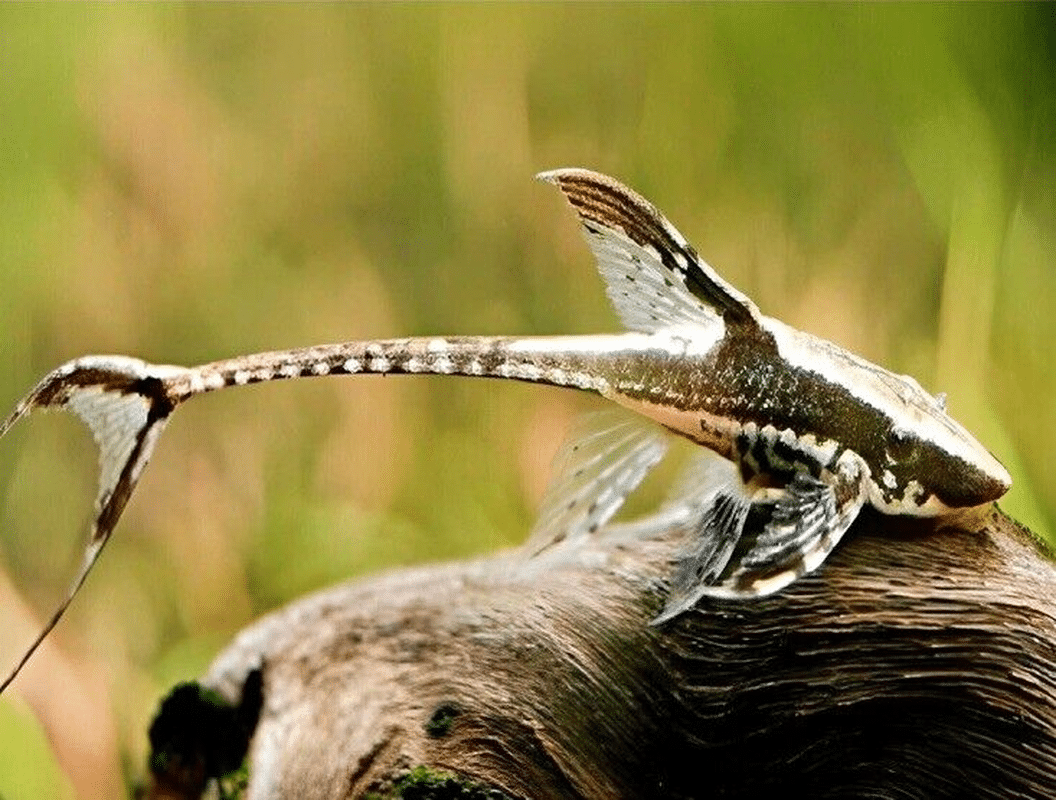

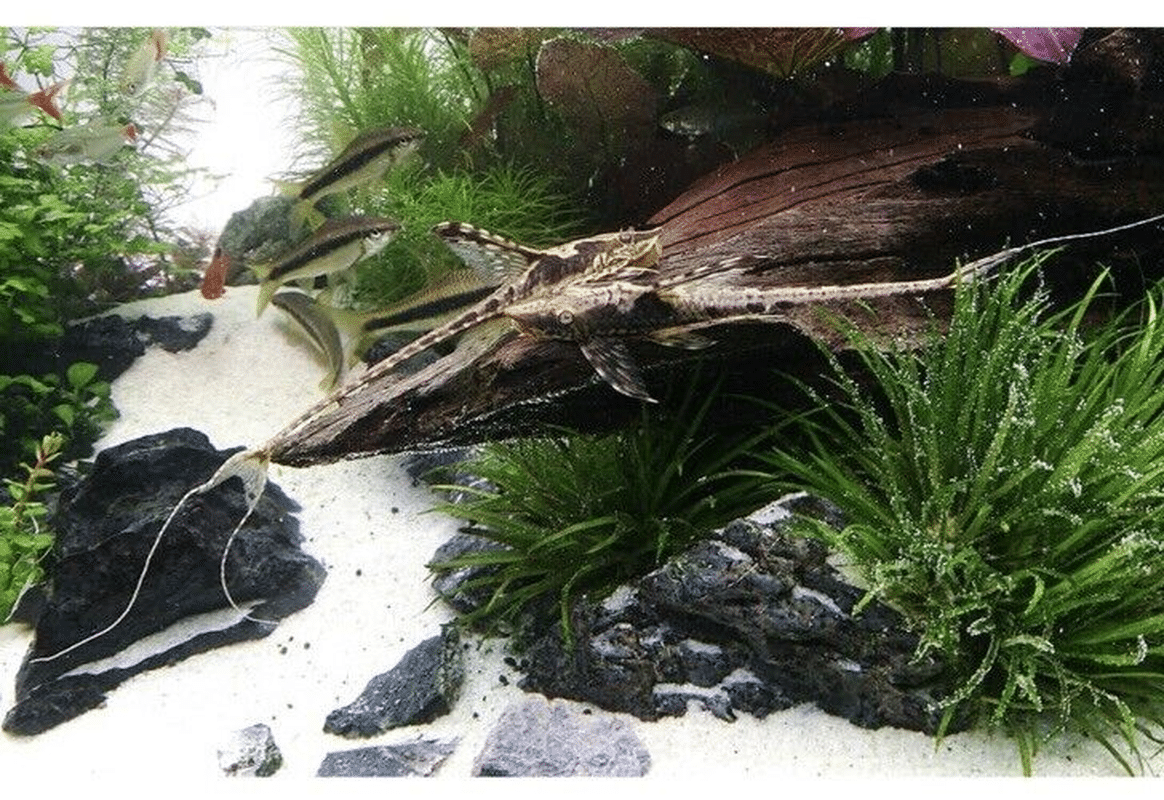




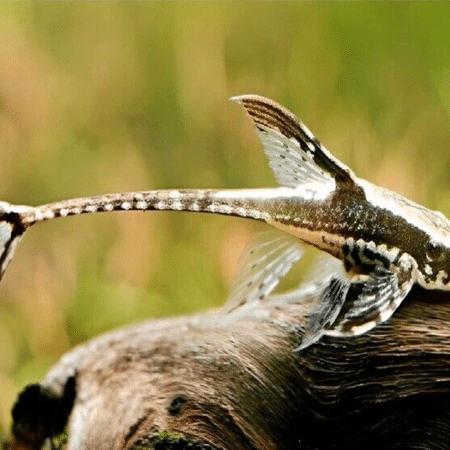
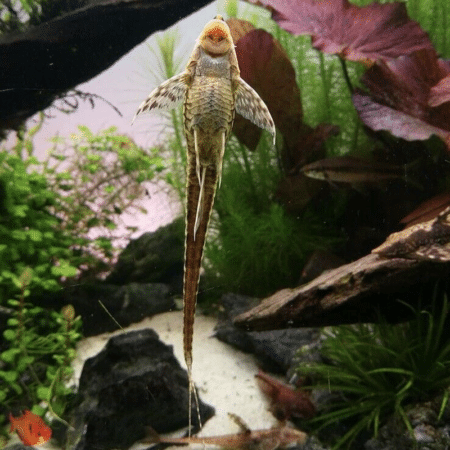
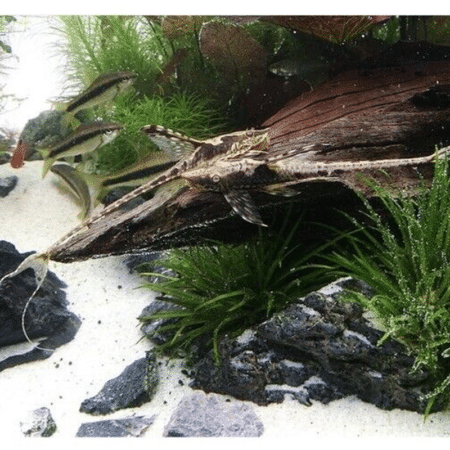
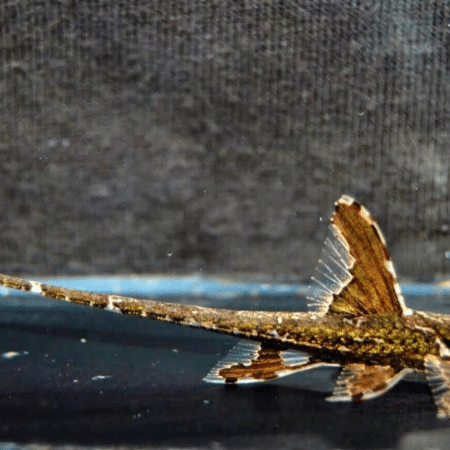
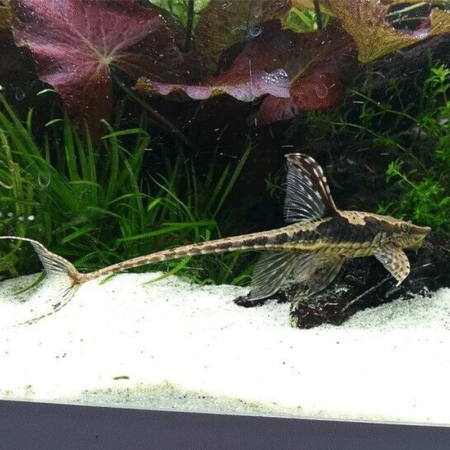
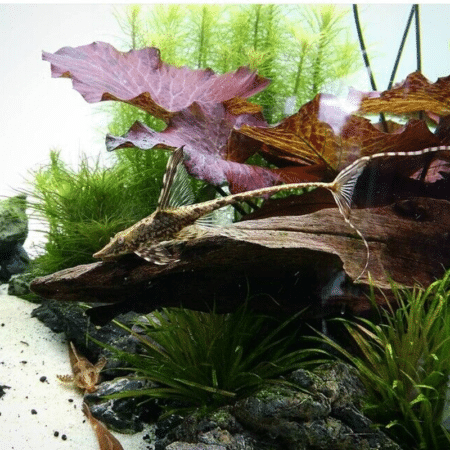
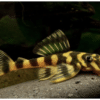
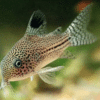












Jessica Lane (verified owner) –
I recently added the Whiptail Catfish (5-7cm) to my aquarium, and I couldn’t be happier with my decision! As a passionate fish parent, I prioritize the health and happiness of my fish, and this little guy has exceeded my expectations. The moment he was introduced to my tank, he started grazing on the algae, making a noticeable difference within just a week. This pleco fish not only provides excellent algae control but also has a unique and charming appearance that adds character to my aquatic environment.
Compared to other algae eaters I’ve tried, like the common bristlenose pleco, the Whiptail is much less aggressive and does well in a community tank. It’s also fun to watch them explore the tank, especially when they venture to hide among the plants and decorations. The only minor issue I noticed is that they do prefer a bit of driftwood or hiding spots, so make sure to provide that in your setup.
For anyone looking to maintain a healthy tropical fish tank, I highly recommend the Whiptail Catfish. It’s perfect for aquarists who want a friendly, low-maintenance algae eater. I’m definitely planning to buy another one soon!
Emily Carter (verified owner) –
I recently added the Whiptail Catfish to my aquarium, and I couldn’t be happier! As a caring fish parent, ensuring my aquatic friends thrive is my top priority. This little pleco, measuring about 6 cm, has not only adapted beautifully but also diligently cleaned up the algae in my tank. Within just a week, I noticed a significant reduction in algae buildup, making my tank look pristine. What I love most is how gentle and peaceful this species is, coexisting with my other tropical fish without any issues. Compared to other algae eaters I’ve tried, the Whiptail is way more active and visually interesting to watch. There’s a minor concern regarding its preference for hiding spots—so be sure to provide plenty of decor for it to feel secure. Overall, I recommend this easy-care freshwater fish to beginners and seasoned aquarists alike. It’s a fantastic way to enhance your aquarium while contributing to a healthy ecosystem. Plus, it arrived quickly and healthy, which is always a plus in my book!